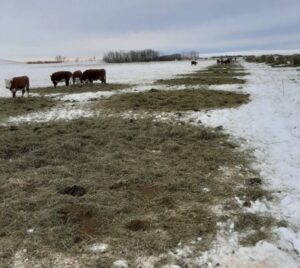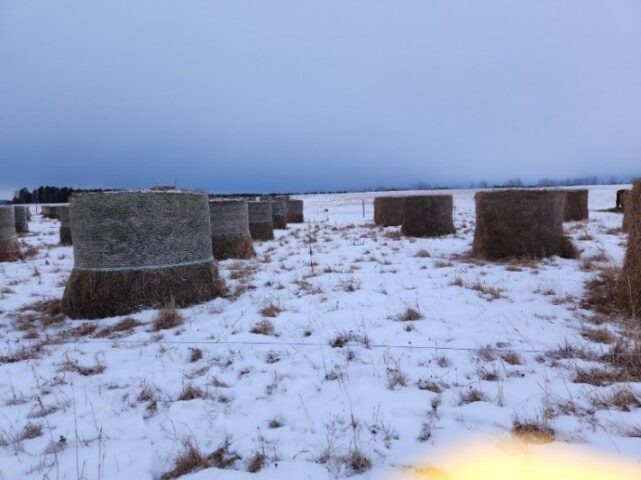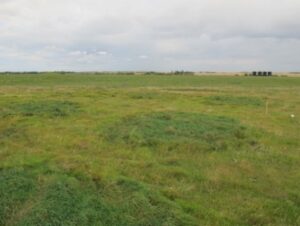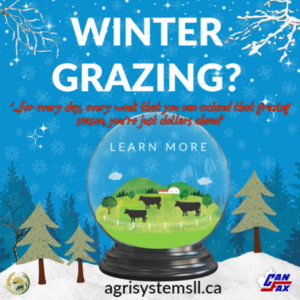Adaptive Winter Grazing Strategies
This article is one of a series of case studies on forage beneficial management practices from Alberta Agrisystems Living Lab and Canfax. It is reprinted on BeefResearch.ca with permission.
Extended grazing can play a key role in lowering your feed costs and can have positive benefits for the health of your land. Some of these benefits include more even manure distribution across fields, less corral cleaning, improved soil fertility and overall reduced fuel use on your operation. One thing to keep in mind with extended grazing is the nutritional or feeding needs for the cattle. Some stages of growth or pregnancy may need more feed than extended grazing can provide. Careful monitoring of the cattle’s condition and feed tests can help you to be successful with extended grazing.
Swath grazing utilizes annual crops, such as cereals or forage crops, that are cut in the fall and left in the field for cattle to graze directly. It can improve soil fertility by directly depositing manure, and trampled feed residue can also build organic matter in the soil.
Bale grazing strategically places bales of hay or forage in designated grazing areas for winter feeding. Producers can optimize feed utilization and enhance pasture productivity by rotating bale locations and distribution.
Both swath and bale grazing offer several advantages over daily feed delivery methods, including reduced feed, labour, machinery fuel costs, residue and manure management costs and reduced reliance on extra fertilizer.
However, there are unique challenges, such as environmental conditions (heavy snow,
freeze-thaw cycles, etc.), feed lost to wildlife, availability of winter watering sources and increased animal energy requirements that must be managed.
Learn more about extended grazing from three producers utilizing these techniques in Alberta.
- Having a backup plan in Central Alberta
- Three-day feed allotments Southern Alberta
- Navigating wildlife in Central Alberta
Key Takeaways for Extensive Winter Grazing
- Extended grazing season: Swath and bale grazing techniques enable grazing for more days in a year, reducing the reliance on purchased or stored feed and associated costs such as machinery, fuel and labour.
- Soil health benefits: Both swath and bale grazing can improve soil health by adding organic matter, nutrients and moisture retention capabilities to grazing sites, leading to enhanced forage productivity and resilience.
- Wildlife and weather management: Strategies such as fencing, timing of swathing and/or grazing, and leaving bales wrapped may mitigate challenges posed by wildlife. It may also be necessary to have a backup feeding plan in case the weather creates conditions not suitable for extended grazing.
- Feed allocation: Matching the feed allocated to the number of cattle and extended grazing days, supplementing as necessary and feeding thin or growing animals separately can help to ensure animal nutritional requirements are met.
- Site selection is important: Not every location is suitable for extended grazing or winter feeding. Avoiding areas that will be harmed by excessive nutrient build-up or subsequent run-off of those nutrients is important.
- Adaptability and learning: Successful swath and bale grazing requires adaptability, careful planning and continuous learning. Mentorship and ongoing management adjustments can help optimize your system.
Having a backup plan in Central Alberta
Terri and Brad Mappin run 225 cow-calf pairs on their ranch located near Byemoor in Central Alberta. They utilize bale, and occasionally, swath grazing to extend their grazing season to limit their daily machinery and fuel use and to lower yardage and overall winter feed costs. The Mappin’s expressed it is a “lot cheaper to go out and move a fence every three or four days. If you’re not starting a tractor until the end of January or even into February or even if it’s at the end of December… for every day, every week that you can extend that grazing
season, you’re just dollars ahead.”
In the past, they have planted an oat with a cover crop mix that includes turnips at the end of May or early June for swath grazing, swathing the crop in late August or early September to the time the swath lays on the ground. Cattle are provided with four half-mile lengths of swaths every three to four days, using portable electric fencing. They make sure that the cattle still have access to shelter, regardless of where the swath grazing occurs. One of their main constraints is their total available cropping acres, which limits the amount of forage they can grow for swath grazing. However, in the years they swath graze, they rotate where the swath grazing takes place to avoid excessive nutrient buildup in any one area.


When they first started bale grazing, they experimented with 125 bales and only bale grazed with bred and first-calf heifers. The bales were placed in six rows, and the cattle had access to one row at a time by moving a portable electric fence. The young heifers stayed in good condition, which prompted them to expand their bale grazing to include their main herd, on pastureland. The Mappin’s do monitor body condition and cull those that are not performing as well on this extensive grazing system. A variety of baled forages are used, for example, last year they used wheat greenfeed that had hail damage. After bale grazing is complete for the season, their cattle remain in an extensive winter-feeding system but are moved to crop stubble, where they are fed silage. This eliminates manure hauling costs and adds some natural fertilizer and organic matter to the cropland.

Aside from managing feed costs, bale grazing has added organic matter and nutrients to the land. Observations via drone images showed visible productivity differences between bale grazed and non-bale-grazed sections. However, they also have encountered several challenges. With drought for the past three years, feed costs have risen. They do not plant a swath grazing crop in dry years, instead opting to silage straight oats. They try to maintain a two- to three-year supply of stockpiled silage or other forages as their “insurance policy” so that they have enough winter feed for their herd in dry years, but several dry years in a row has lowered the desired stockpile inventory.
Top Tips
- Have backup feed: Stockpiling extra feed provides flexibility in winter feeding plans and can mitigate the impact of unpredictable weather patterns on feed availability.
- Enjoy the benefits: Implementing extensive grazing systems reduces winter-feeding days, lowering machinery use and labour hours.
Three-day feed allotments in Southern Alberta
Kelly and Glen Hall’s ranch is located near Parkland in Southern Alberta, where they raise 180 head of Simmental cross cows and custom-feed backgrounders. As seasoned practitioners of both bale and swath grazing, their approach prioritizes cost reduction and labour efficiency, while fostering land rejuvenation. They have a goal to convert land they currently swath graze back into perennial forage production for a full bale grazing setup.

In their swath grazing endeavors, Kelly and Glen strategically rotate cattle off swath-grazed fields before spring ground softens to prevent soil compaction. Additionally, they adjust grazing directions each year to distribute manure evenly. When thin swaths are at risk of rain damage or wind dispersal, they opt to bale those swaths to preserve nutritional value.
The Hall’s bale grazing is aimed at reducing manure hauling costs associated with confined feeding systems. When they transitioned to bale grazing a decade ago, they started with mature cows nearing the end of their second trimester. Now, replacements along with first and second calvers are separated from the mature cow herd and fed in a separate bale grazing group to reduce feed competition and allow those younger animals to maintain body condition over the winter more easily.
Before the winter-feeding season, Kelly and Glen calculate approximately how much feed will be needed. They start by estimating feed intake at 2.5% of body weight per day and add in a bit more for supplementation or increased intake during extreme weather. Then, using the number of cattle in each group and three-day feed allocations, they can determine the pounds of forage (or number of bales) needed to optimize feed utilization, using temporary fencing to only allow access to that amount of feed.

Before letting cattle into each individual section, bale twine is removed. Overall, they find hay is less wasteful than greenfeed for bale grazing because greenfeed often falls apart faster after taking the twine off. “It just poofs when you take the strings off compared to hay. Hay sticks together better. Greenfeed is a little trickier because it just kind of explodes when you take the twine off because it’s slippery. Cows are much more respectful of a round bale than the yearlings are.”
They leave the bales in the field where they were made to minimize transportation and add nutrients back into the soil. They bale graze multiple fields that have perimeter fencing and water access and try to rotate them from year to year. The fields selected for bale grazing also depend on that year’s forage yield as they would rather take the cattle to the bales.
When the cows are given their pre-calving vaccinations, they are taken off bale grazing, put on stockpiled grass and supplemented with rolled-out bales. Kelly and Glen like to remove cattle from the hay fields before the ground softens to avoid ruts and to keep those fields from getting too rough.
Some of the challenges faced are weather and wildlife, including mule and whitetail deer consuming forage. However, the weather is a greater concern for Kelly and Glen, as Chinook winds cause snow to drift and build up on the sides of bales, making twine removal difficult. Sometimes a hard crust forms on top of the swaths, making them harder for the cattle to access. To mitigate the impacts of wind and blowing snow, they use portable wind fences to provide protection for both the cattle and feed.
Kelly and Glen noted that their cattle have more room to exercise and are healthier and even happier. They also find the cattle are cleaner, with less tag in the winter grazing system compared to the confined system.
Top Tips
- Find a mentor: Talking to somebody with previous experience can aid in learning and help further improve practices in your operation.
- Be flexible: When thin swaths are at risk of rain damage or wind dispersal, they opt to bale them to preserve nutritional value or blowing away.
- Manage ground with re-seeding in mind: Rotate cattle off swath-grazed fields before spring ground softens to prevent soil compaction and rutting. Adjusting grazing direction can spread manure evenly.
Navigating wildlife in Central Alberta
For many years, Doug and Deb Skeels have run a cow-calf operation with 60 cows and a backgrounding operation south of Rocky Mountain House. They have been bale grazing for about ten years and have used other winter feeding systems in the past, but find bale grazing is the best fit for their operation.
In the fall, after weaning, the bred heifers and young cows are separated from the main herd for winter feeding, limiting competition for feed and ensuring heifers maintain body condition. Once the cows are older, they join the main cow herd on bale grazing. The cows sometimes get silage after bale grazing is done in April and calving starts. “We started out in this business 30-some years ago. We used to calve our cows in the corral in February and now looking back, that was maybe the worst thing we could have done.” They set out about one bale per 10 cows for a three-day period. If the weather is colder, cattle will be moved every two days, but they typically stick to three-day moves on mild winter days. “There’s 8 to 12 hours of machine time to set out my whole grazing system for the winter, you know, almost every other system requires an hour or two of tractor time at least every second day, if not every day.”


The perimeter fence for the bale grazing field is high tensile wire. They use rebar posts with insulators and 1/16 cable on a reel for their temporary fencing. A ball peen hammer is used to put in the rebar, and to take them out in the spring, they use a basic pipe wrench. In the past, they have had to weld together longer rebar posts when snow was deeper to reach the ground and ensure the fence was high enough. The 1/16 cable is very visible, and they find cattle pay attention to it more. A 12-volt solar power system powers their electric fence. They also have a permanent 24-volt solar-powered water system.

If bale grazing is done on a hill, Doug moves cattle up the hill to the next section of bales. If bales roll down the hill, then they do not disturb the fencing to the next section of bales. The Skeels prefer to use net wrap and stand the bales on end to make it easier to remove the net wrap. They leave three quarters of the net wrap on with the bottom quarter of net wrap removed so it does not freeze to the ground. Leaving some of the net wrap on ensures that the hay does not blow away and helps deter deer from eating the bales as much as possible. Overall, they find that net wrap is easier to take off than twine. Doug states, “The deer here are our biggest challenge, but they will generally stay a little way away from the cows. When you get to the end of the bale grazing sections, then sometimes the deer get tangled in the fences and tear them down.” Moose are worse because they do not care about the fences, but Doug has not yet had any moose trying to eat their bales. He recognizes that moose and elk can be a problem in other areas.
The Skeels rotate where they bale graze each year through different sections of the same pasture. Bale grazing is completed in the first part of April before calving. Calving is done on pasture, further eliminating the need for manure storage and hauling.
Top Tips
- Manage body condition: Separate young females and feed them separately to limit competition for feed and to maintain body condition score for rebreeding.
- Graze uphill: They graze their bales uphill. That way, any bales that may roll down do not roll into the next fence line but instead into the previously grazed area.
- Manage for losses: Leave some twine/net wrap on the bales until just before feeding to reduce potential wildlife or weather losses
Click here to subscribe to the BCRC Blog and receive email notifications when new content is posted.
The sharing or reprinting of BCRC Blog articles is typically welcome and encouraged, however this article requires permission of the original publisher.
We welcome your questions, comments and suggestions. Contact us directly or generate public discussion by posting your thoughts below.


